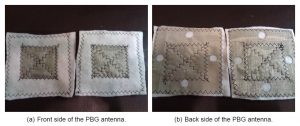Abstract del Mejor Proyecto Fin de Máster del Máster Universitario en Ingeniería de Telecomunicación.
Autor: Rubén del Río Ruiz Director de Proyecto: Juan Manuel López Garde
Nowadays, communications play an important role in our society. More and more people benefit from the advantages of personal communication systems, intelligent transport systems or mobile satellite systems. Highly efficient wireless communication channels are needed to provide users’ services in an efficient way. Antennas are a key point for devices to be able to communicate between them and other devices. Communication modules are becoming smaller and smaller, making wearable and corporal technology more feasible for upcoming gadgets embedded in clothing. The integration of electronics into textile heralds is the new era for the apparel industry. The garment of the future will not only protect the human body against the extremes of nature but also provide information about the environment and the wearer’s health.
This project accomplishes the design, manufacture and verification of textile patch antennas. The antennas have been designed for ISM-band systems, with a central frequency of 2,44GHz, and 80MHz bandwidth. First it has been done a broad study and validation of the dielectric and conductive textile materials, where those with better electrical and dielectric characteristics have been chosen. A second broad study has been done about microstrip design and construction methodologies, where the most suitable methods have been chosen. Third the patch antennas have been designed and simulated with the Agilent ADS (Advanced Design System) software. Fourth the results of these simulations have been taken into account in order to choose which ones would be constructed. The criteria used for manufacturing the prototypes, has been a return loss lower than -10dB in the whole ISM-band bandwidth. Fifth the antennas have been manufactured and measured in order to obtain their EM characteristics. Sixth a comparison has been performed to study the differences between simulated and real results. Seventh, antennas have been optimized by painting the radiation patches with conductive adhesive, and by introducing photonic band-gap structures in ground layer. The manufactured antennas have shown good radiation parameters, such as a gain rounding 8 dB and return losses lower than -10dB in the whole bandwidth. Finally, some conclusions have been drawn regarding the design, simulation and construction of textile patch antennas.


Good post! We are linking to this particularly great articdle on oour website.
Keep up the great writing.